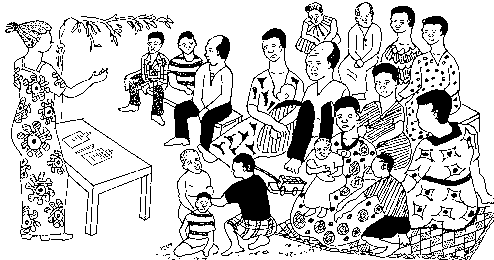Tweet
Translations:
'العربية / al-ʿarabīyah
Bahasa Indonesia
Български език
Català
中文 / Zhōngwén
Deutsch
English
Español
Euskara
Ewe
Filipino/Tagalog
Français
Galego
Ελληνικά / Elliniká
हिन्दी / hindī
Italiano
日本語 / Nihongo
Kiswahili
한국어 / Hangugeo
بهاس ملايو / Bahasa Melayu
Português
Română
Српски / Srpski
>తెలుగు /Telugu
ไทย / Thai
Türkçe
اردو / Urdu
Other formats:
Other Pages:
Modules
Site Map
Key Words
Contact
Utility Documents
Useful Links
PUBLIC DIALOGUE
How to Conduct a Public Meeting
by Phil Bartle, PhD
Training Handout
The mobilizer needs skills to communicate with the people in the community
For both raising awareness and community organizing, your main tool is a public meeting in which discussion is the central feature.
Here it is very important that you are thoroughly informed and conversant with your mobilizers' goals, as indicated above, and the key concepts, as in keywords.
And more.
Do not memorize definitions; reinterpret all those concepts as you understand them, and debate them in your journal and with colleagues. Do not preach sermons like a priest; do not make speeches like a politician; do not lecture like a professor, avoid pontificating, haranguing, or dictating.
Facilitate. Ask questions. Guide.
Your best role model should be that renown educator of ancient Greece, Socrates, who taught by always asking questions, never giving answers.He was a great facilitator, guiding people to think (analyse, observe) for themselves.
Appear relaxed, confident and informed. Draw questions out of the participants.Especially ask the quiet and shy ones for their opinions. Do not allow the over confident and dominating ones to take over or control the discussion.
In the public meetings you also introduce the "brainstorm" session, which you will use again in planning sessions of the executive committee.
Explain that different kinds of sessions have different ground rules.
The open dialogue, where you guide by facilitating and questioning, allows for debate and cross talk; the "brainstorm" does not.
In a brainstorm you emphasize that there is no debate, no criticism, no cross talk. You will call for suggestions and write them on the board, all of them, even the silly ones, and later prioritize the list of suggestions. The "brainstorm" is very structured and focussed and the participants must learn and practice the ground rules.
Never tell a community group what to think or what to do.
You may want to, for you have your goals of empowering them, fighting apathy, ignorance, dependency, disease and dishonesty (the causes of poverty). But you have to facilitate them in coming to their own realization, and their own decision. You must take this facilitation approach if you want to empower or strengthen them. (Avoid lecturing and preaching).
––»«––
Community Gathering
 |